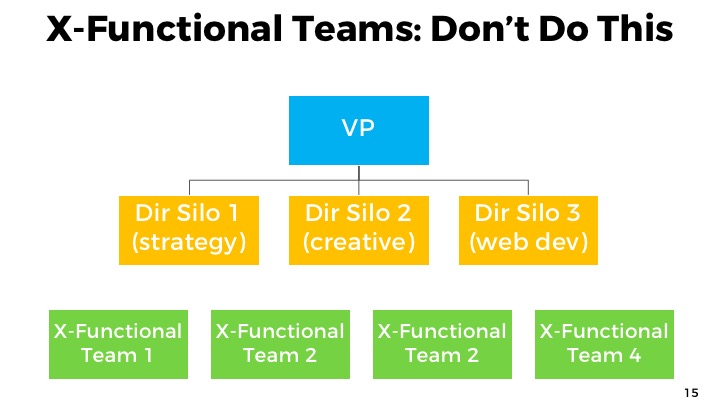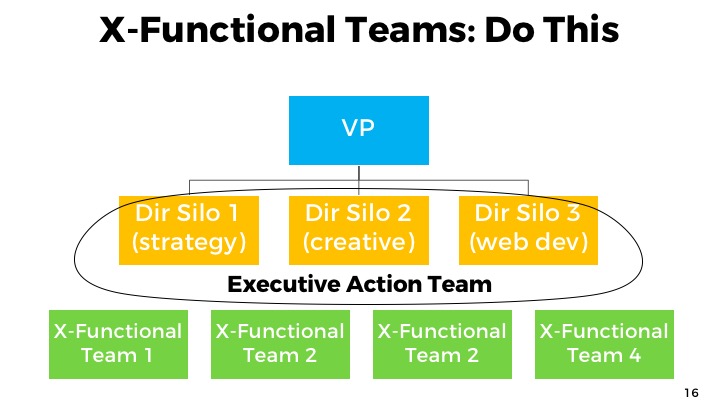 I often tell my clients who are getting started with Agile Marketing to implement Agile Marketing in an Agile fashion. In other words, start small and iterate,learning through experimentationand measuring what’s working and what’s not.
I often tell my clients who are getting started with Agile Marketing to implement Agile Marketing in an Agile fashion. In other words, start small and iterate,learning through experimentationand measuring what’s working and what’s not.
Do not try to implement Agile Marketing with a big, six month plan and a complete re-organization. You don’t know enough at the beginning to do this successfully and the big bang approach is likely to fail.
Pick One or Two Areas to Start
In a small or medium size company (less than 50 marketers) where you are getting started on Agile Marketing, pick one area to start. In a large company where you are getting started on Agile Marketing, pick two areas. Note that you are not picking projects, with a beginning and an end. Instead, you are focused on some area of your business where you can improve customer outcomes over time. Describe the area in customer language. You may even write out a user story, although it has to be the kind of user story that would be implemented over many iterations (an Epic, in Scrum language).
Here are some examples:
- Improve the comparison shopping experience (As a “name your biggest competitor” customer, I want to understand how you compare to my current supplier, so that I can save money or get a better product)
- Launch a new product line (“As a shopper for ‘new product line’, I want to . . .)
- Educate me (“As someone new to your product category, I want to be educated on the benefits and the options of choosing a product in your category so that I can feel like I’m making an educated decision”)
Which Areas to Pick?
I generally tell clients that are getting started on Agile Marketing that the right areas to pick generally have three characteristics:
- The right level of risk/reward – pick areas that are neither bet the business areas or so small and trivial that succeeding in them won’t make a difference to the business. Ideally, pick something that is of medium risk, and where improvements and the impact of better marketing will be clearly realized (medium or high reward).
- New areas or ones that are struggling – A new product or a new business investment can often be a good candidate for Agile Marketing. By definition, you have a lot of learning to do in this new area, and Agile Marketing’s iterative, adaptive approach fits new product areas very well. If you can learn rapidly and change your approach based on what’s working and what’s not, you’re more likely to succeed with a new area.
Similarly, you might choose an area that is struggling. Again, trying out some new experiments and iterating on what works and what doesn’t is likely to improve a struggling business. Unless the problems are intractable, Agile Marketing can help you improve a struggling business. - Areas that can show the value of cross-functional teams – this is particularly relevant for larger companies. Inevitably, larger companies have marketing processes that are struggling because completing these processes requires multiple skill sets, and prioritization conflicts between the various skill set silos slows down the process. If you have an area of your marketing that could clearly benefit from the focus of a cross-functional team, it should be a candidate for an early implementation of Agile Marketing.
Kickoff by Describing the Scope and by Defining Success
It sounds obvious, but many get started on Agile Marketing without clear definitions of what success looks like. We want everything: faster, better, less cost, etc. Get specific. What improvements are most important? Is it the customer experience? Is it the efficiency of marketing? How will you measure this?
Sometimes you don’t know enough about a new area to write SMART goals. You remember these, they’re Specific, Measurable, Achievable, Results focused and Time bound. The specific goals may emerge over time. However, you can decide what is most important to measure and measure the improvement rather than set a specific target.
You should also describe the scope of the area that you are focusing on. What triggers the customer to enter your customer experience? What is the first step? What is the last step? How much budget does this project have? Who is on the team? What’s the time frame for measuring improvement?
I’ve created an Excel spreadsheet that you can use as a scope document. You can download it here: Scope and Charter spreadsheet.
Managing Your Initial Agile Marketing Investments
The most important decision you will make in getting started with Agile Marketing will be to choose the marketing owner(s) for your initial investments. Who will decide which user stories will be prioritized? Who will work with the scrum master to refine the backlog and refine the individual user stories? Choosing the right person is critical to the success of these early investments.
I also recommend that you form an executive action team, consisting of the heads of the skill set silos involved in the cross-functional team. They should have responsibility for the success of these cross-functional Agile Marketing teams.

 Let’s face it – the implementation of cross-functional teams can be very threatening to the leaders of the current skill-set silos. They may feel that this new way of working threatens their jobs and their power. If you don’t put these middle managers on an executive action team, consciously or unconsciously, they may sabotage the implementation of cross-functional teams.
Let’s face it – the implementation of cross-functional teams can be very threatening to the leaders of the current skill-set silos. They may feel that this new way of working threatens their jobs and their power. If you don’t put these middle managers on an executive action team, consciously or unconsciously, they may sabotage the implementation of cross-functional teams.
The responsibilities of this Executive Action Team are the following:
- Create an Agile Marketing Reference Model that will scale within the organization, including cross-group operational rules, procedures, and guidelines
- Measure and improve the quality of Agile Marketing
- Build Agile Marketing capacity within the organization
- Create a center for continuous learning of Agile Marketing
- Support the exploration of new ways of working
- Remove obstacles for the cross-functional teams
They should meet at least weekly, and sometimes as much as three times per week. They should be very clear that the success of these initial Agile Marketing investments is their responsibility, and that it will be something that will appear on their review.
Implement Scrum or Kanban to the Letter for at Least Six Months
I see many beginning Agile Marketing teams implementing parts of Scrum or Kanban, but not implementing other parts. That’s fine if you’ve had a chance to practice those parts of Scrum or Kanban for some time and found, empirically, that they don’t work for you. But often, that’s not the case.
I see teams that don’t practice retrospectives, from the beginning, so they don’t realize the benefits of gathering feedback and iterating on their process. I see other teams that don’t practice Sprint Reviews, and they don’t get the benefit of feedback from and exposure of the good work that they’re doing to the business teams.
I highly recommend that teams practice Scrum or Kanban to the letter for at least six months before they start dropping some aspects, adding others or combining aspects of each. This will give the team time to understand the value of each ceremony, each artifact, each principle.
Get Agile Marketing Training
Scrum and Kanban have to be adapted to work for marketing. There is now a certification for Agile Marketing from IC-Agile. Classes are available in a number of locations. Get training and learn now to adapt Scrum and Agile to your marketing practice.
Get a Coach
Yes, I know that this is self-serving, but a coach can save you lots of time and frustration and many times be the difference between success and failure. They’ve seen some or most of the common mistakes before. They have an outsider’s perspective. Even if you hire someone at the beginning and then for once a month check-in’s, I highly recommend a qualified coach.
Getting Started with Agile Marketing: Follow the Agile Principles
I end this blog post where I began: implement Agile Marketing in an Agile fashion. Start small, with a goal of learning, not success or failure. Follow these principles:
- Make a small plan and then adapt
- Iterate (in time, rapidly)
- Validated learning over opinions and conventions. Choose what to do in your Agile practice based on measurements of what works, not based on higher up’s opinions
- Many small experiments over a few large bets. Try some different ways of working. Make a number of small bets and experiments, rather than trying to adopt Agile Marketing as one big bet.
- Individuals and interactions over one size fits all. Everyone is different, and your adoption of Agile Marketing will be different than that of others. You can learn from others, but find something that fits your business uniquely.
- Collaboration over silos and hierarchy. Collaboration is one of the big benefits of practicing Agile Marketing. Make sure that it is recognized and rewarded. Look out for silos and hierarchies that try to sabotage the move to Agile.
Good luck and let me know how I can help.




Hi there. I really enjoy your blog posts and have read your newsletter on the intro to Agile. It’s very exciting and useful.
I have a question about your first paragraph under Which Areas to Pick? I may be wrong, but it reads as if there are some words missing, perhaps? I have read it several times and I don’t get the full meaning.
Would you please, if you have the time, let me know what is it supposed to say or what I missed? THANK YOU!
Heather, thanks for the kind words. Not sure I understand your question. In the paragraph, I’m trying to say that teams that are beginning their Agile Marketing journey should start in areas that possess three characteristics: the right level of risk/reward (neither highly risky nor low risk/low reward), new business areas or areas of your business that are struggling, or ones that could benefit from cross-functional teams. Does that help clear it up?